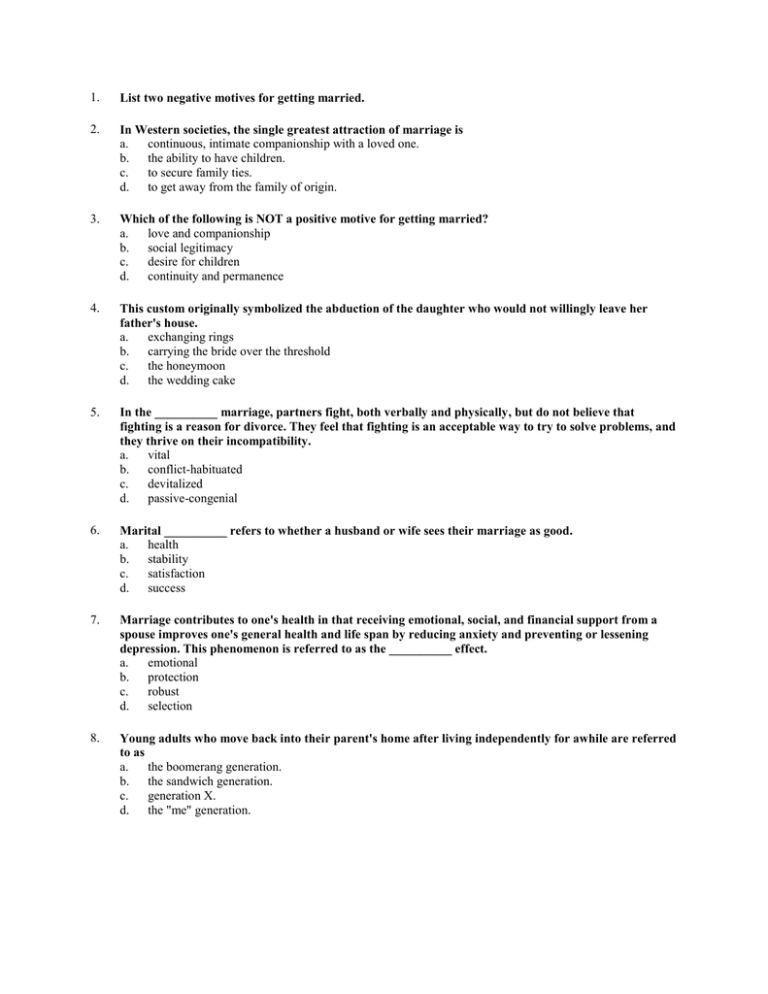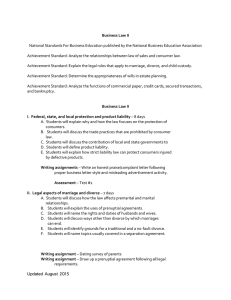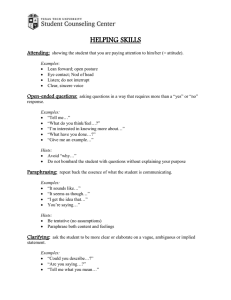Quick Quiz 10, 15, 16.doc
advertisement

1. List two negative motives for getting married. 2. In Western societies, the single greatest attraction of marriage is a. continuous, intimate companionship with a loved one. b. the ability to have children. c. to secure family ties. d. to get away from the family of origin. 3. Which of the following is NOT a positive motive for getting married? a. love and companionship b. social legitimacy c. desire for children d. continuity and permanence 4. This custom originally symbolized the abduction of the daughter who would not willingly leave her father's house. a. exchanging rings b. carrying the bride over the threshold c. the honeymoon d. the wedding cake 5. In the __________ marriage, partners fight, both verbally and physically, but do not believe that fighting is a reason for divorce. They feel that fighting is an acceptable way to try to solve problems, and they thrive on their incompatibility. a. vital b. conflict-habituated c. devitalized d. passive-congenial 6. Marital __________ refers to whether a husband or wife sees their marriage as good. a. health b. stability c. satisfaction d. success 7. Marriage contributes to one's health in that receiving emotional, social, and financial support from a spouse improves one's general health and life span by reducing anxiety and preventing or lessening depression. This phenomenon is referred to as the __________ effect. a. emotional b. protection c. robust d. selection 8. Young adults who move back into their parent's home after living independently for awhile are referred to as a. the boomerang generation. b. the sandwich generation. c. generation X. d. the "me" generation. 9. When a listener offers concrete help, such as shopping for food or caring for children, she/he is giving __________ support. a. esteem b. information c. instrumental d. motivational 10. Which issue is at the top of the list of the things couples fight about? a. money b. housework c. children d. sex 11. How is divorce a process? 12. Which of the following statements about divorce is true? a. A majority of American adults believe that divorce is morally unacceptable. b. On average, first marriages that end in divorce last about 20 years. c. After a divorce, mothers are more likely to have custody of children than fathers. d. In 2007, among men who had ever been divorced by age 70, the largest percentage were white. 13. The legal and formal dissolution of a marriage is called a. separation. b. dissolution. c. resolution. d. divorce. 14. Which of the following statements about divorce is accurate? a. Half of all marriages end in divorce. b. Over a lifetime, a majority of American marriages end in divorce. c. Divorce is less likely today than it was thirty years ago. d. Between 2000 and 2008 the divorce rate increased. 15. According to Bohannon, in the __________ stage of divorce, the couple together inform friends, family, and teachers that they are no longer married. a. community b. psychic c. economic d. co-parental 16. The text points out that many demographic variables help explain the divorce-prone couple. Which of the following is NOT one of these demographic variables? a. parental divorce b. the presence of children c. age at marriage d. changes in technology 17. In real life, divorce is usually a. not a stressful experience. b. an agonizing process for both sexes. c. only difficult for the less affluent. d. a simple process to work through. 18. Which of the following is the most common type of custody agreement? a. split custody b. joint custody c. local custody d. sole custody 19. Which of the following statements concerning the negative effects of divorce on children is inaccurate? a. Most of children's problems after divorce are due to the divorce itself. b. Children's adjustment to divorce depends on the quality of parenting they experience after the marriage ends. c. Economic hardship after divorce has a negative effect on children's well-being. d. Typically, divorce crystallizes rather than creates long-standing family problems. 20. Which of the following statements about counseling and marital therapy is accurate? a. Many scientific studies have shown counseling to be very effective at preventing divorce. b. Counseling is less effective if the counselor serves as an impartial observer. c. All marriages are salvageable if the partners get help to work through their problems. d. Counselor can help couples and families decrease some difficulties such as parenting problems. 21. Why do some stepfamily organizations dislike the term blended family? 22. _________ Americans who divorce remarry. a. Very few b. Half of all c. Most of d. All 23. Among racial and ethnic groups, which group of women is most likely to remarry? a. black women b. white women c. Latinas d. Asian American women 24. In which stage of remarriage does a couple have to deal with issues such as who supports the children of the relationship – the custodial parent and stepparent or the noncustodial biological parent? a. economic remarriage b. legal remarriage c. community remarriage d. parental remarriage 25. Brothers or sisters with whom you share one biological or adoptive parent are __________ siblings. a. step b. half c. foster d. adoptive 26. Which of the following myths about stepfamilies includes the expectation that the new mate will be everything the problematic old mate was not? a. the Nuclear Family Myth b. the Compensation Myth c. the Instant Love Myth d. the Rescue Fantasy Myth 27. In the __________ family, all of the children are biological children of the father and stepchildren of the mother. a. complex stepfamily b. joint stepfamily c. mother-stepfather d. father-stepmother 28. Stepfamilies differ from nuclear families in many ways that make steparenting more difficult. Which of the following is NOT one of these ways? a. Stepfamily integration typically takes years rather than months. b. Important relationships may be cut off or end abruptly, and others spring up over night. c. Stepfamilies roles are too strictly defined. d. Stepfamilies may have loyalty conflicts. 29. Two of the biggest problems in stepfamilies involve a. love and understanding. b. compassion and listening. c. hopes and fears. d. discipline and authority. 30. Which of the following is NOT a trait of a successful stepfamily? a. They have developed realistic expectations. b. They let the children mourn their losses. c. They focus on the children rather than on the couple. d. They know that the stepparenting role proceeds slowly. Test Name: Quick Quiz 10, 15, 16 1. Social legitimacy: getting married to legitimate an out-of-wedlock baby is one of the worst reasons for marrying. Social pressure: parents and friends may pressure a couple to get married. Economic stability: money won't sustain a marriage over time. Rebellion or revenge: marrying to get away from one's family is not a good foundation for marriage. Practical solutions to problems: people may marry to help them solve their problems or provide other types of practical help. Feedback: Hints: 2. a. continuous, intimate companionship with a loved one. Feedback: Hints: 3. b. social legitimacy Feedback: Hints: 4. b. carrying the bride over the threshold Feedback: Hints: 5. b. conflict-habituated Feedback: Hints: 6. c. satisfaction Feedback: Hints: 7. b. protection Feedback: Hints: 8. a. the boomerang generation. Feedback: Hints: 9. c. instrumental Feedback: Hints: 10. a. money Feedback: Hints: 11. Few divorces are spontaneous, spur-of-the-moment acts. Instead, the divorce process is usually spread over a long period during which the couple gradually redefines their relationship and their expectations of each other. Feedback: Hints: 12. c. After a divorce, mothers are more likely to have custody of children than fathers. Feedback: Hints: 13. d. divorce. Feedback: Hints: 14. c. Divorce is less likely today than it was thirty years ago. Feedback: Hints: 15. a. community Feedback: Hints: 16. d. changes in technology Feedback: Hints: 17. b. an agonizing process for both sexes. Feedback: Hints: 18. d. sole custody Feedback: Hints: 19. a. Most of children's problems after divorce are due to the divorce itself. Feedback: Hints: 20. d. Counselor can help couples and families decrease some difficulties such as parenting problems. Feedback: Hints: 21. They argue that stepfamilies don't blend. Instead, there are more parents, children have divided loyalties, and stepfamilies must develop new and unfamiliar roles for all their members. Feedback: Hints: 22. c. Most of Feedback: Hints: 23. b. white women Feedback: Hints: 24. a. economic remarriage Feedback: Hints: 25. b. half Feedback: Hints: 26. b. the Compensation Myth Feedback: Hints: 27. d. father-stepmother Feedback: Hints: 28. c. Stepfamilies roles are too strictly defined. Feedback: Hints: 29. d. discipline and authority. Feedback: Hints: 30. c. They focus on the children rather than on the couple. Feedback: Hints:





